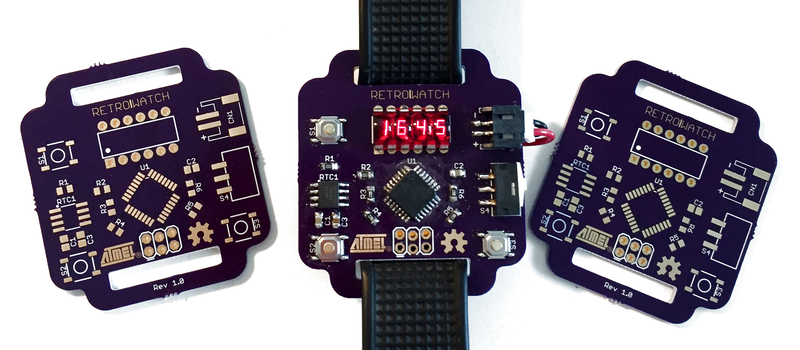[Rafael] made a sweet little retro watch that’s a fantastic introduction to hardware DIY. If you’ve programmed an Arduino before, but you’ve never had a board made, and you are up for some SMD soldering, this might be for you. It’s got some small components, so ease off the coffee before soldering, but it’s nothing that you won’t be able to do. In the end, you’ll have something awesome.
Aesthetically, the centerpiece is the bubble display, which reminds us of the old HP calculator that our parents kept in the junk drawer, long after it had ceased to be relevant. It would return 3.9999999 for the square-root of 16, but we loved to play with it anyway. This watch will let you vicariously reclaim our childhood.
But that’s not all! It’s also an Arduino and RTC clock. Functions that are already implemented include clock, calendar, stopwatch, and “temperature”. (Temperature is from the AVR’s internal thermometer, which isn’t super-accurate and is probably just going to tell you how hot your wrist is anyway…) It’s got buttons, and tons of free flash space left over. It’s begging to be customized. You know what to do.
It’s not a smart watch, but it’s a great project. “The nostalgic retro bubble display is certain to flatter any hacker’s outfit.” Or something. OK, but we want one.
[via OSHpark’s Hackaday.io feed]















I want one! But I probably wouldn’t actually wear it. Let’s see what I have in the junk drawer here….
Wow ! This is crazy ! I never expected to be featured here on my second project !
I’m already working on V2 based on the Adafruit Feather, with Micro USB charging and programming, but with even smaller components like 0603s and QFNs to test my hot air reflow skills. Check back on the GitHub repo soon to see it !
Wow. This is crazy ! I never expected that for my second project. Thank you very much for the shoutout ! V2 coming soon with even cooler features ! Check back on my GitHub soon to see it !
You can do that with a 555!
This looks cool and all, but there’s no mention of a battery that will fit nicely under it.
I used 500 mAh LiPo batteries from Adafruit. The board was designed so that one of those would fit under.
I have smaller and much smarter https://www.tindie.com/products/bobricius/retro-wrist-watch-with-bubble-display-qdsp-6064/
Why is this $68, without the DS3231? Is it made of gold?
No but with golden hands … iPhone is only any chip and piece of glass.
Nice ! Gave me some ideas for more features :)
This watch has RTC chip, but not 32khz quartz?
Ok, found out – it has internal oscillator in the RTC. Wow, haven’t known they had those.
I had a quick look around – the DS3231 has two versions, one with an internal quartz oscillator, and one with an internal MEMS oscillator. The budgetary pricing (1000k units) from Maxim is $3.54 for the mems and $3.85 for the quartz version. Expensive, but I can see applications where you need the space/want a simple solution/need the accuracy.
The internal XTAL oscillator or temperature compensated so it’s very accurate and it has battery backup.
Oops ! Sorry for the double post !
Great work Rafael! Im ordering all the parts to make my own now :)
Great ! Let me know how it goes ! And also if you have any questions !
Nice job, Rafael. I remember when those magnified bubble LED’s were all we mere mortals could afford. At one point I recall pricing half-inch non-magnified seven segment LED’s like the ones in the newer instruments in my father’s lab and they sere something like seven dollars each. For one digit. IN 1978.
Wow ! It’s crazy how far electronics have come !
Electronics was just a hobby for me at the beginning and it was one of the most expensive hobbies you could have. Even racing motocross with the expense of motorcycles, equipment and the traveling up to 2000 km for some annual events was less expensive.
Damn, we’ve come a long way.
I have been thinking about something like this to use up the 90 or so bubble displays I have in my bins. Maybe I’ll dig them out and try this.
Really nice job. Too bad the bubble display has been discontinued by Sparkfun. Any other official supplyer out there ?
https://shop.pimoroni.com/products/retro-4-digit-led-display
Many thanks.
Seems I didn’t google enough :)
Also on ebay http://www.ebay.com/itm/272313468227
Little more expensive but might be able to get a deal with best offer. I bought a set for $10 off them to build this about a week ago.